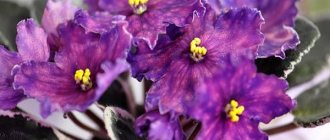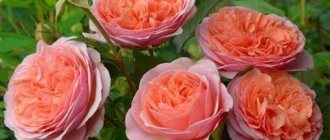What are there
David Austin is an English breeder who developed new varieties of roses by crossing Floribundas, hybrid teas and ancient species.
New varieties appeared in the 80s of the 20th century. They are not separated into a separate class; they belong to English roses, scrubs (bush types). Other names are Austin roses, “Austins”. The number of hybrids bred is more than 200.
Main differences
David Austin selected plants with certain criteria:
- The bud is rosette, pomp-shaped, cup-shaped.
- Rich aroma - intensity changes in the morning and evening hours, depending on weather conditions (sunny, cloudy weather).
- The bush is round, tall or medium, the shoots are straight or hanging.
Other types of buds: cup (shallow, deep, open), reverse-curved, cross-shaped rosette.
The number of petals is from 40 to 200, there is a velvet effect.
There are five types of aroma: musk, myrrh, fruity, tea and antique roses. Most species combine several types into one and change strength at different times.
The necessary criteria were selected from the mother plants:
- color (appearance of yellow, wine colors) – hybrid tea;
- pleasant smell (berry, fruit, citrus) against the background of the old ones;
- repeated, wave-like appearance of new buds, inflorescence of 5-10 pieces - floribunda.
Peculiarities
Austinkas have advantages over other flowering perennial plants that are easy to maintain with proper care:
- Abundant flowering all summer and autumn (without interruption or wavy).
- Can be planted in semi-shady, shady places.
- There is no growth if the plant is planted correctly (the neck is deepened by 3-4 cm).
- They rarely suffer from fungal diseases.
- Can be used for various purposes (cutting, mixed plantings, decorating fences, gazebos).
Disadvantages that appear if the plant is planted incorrectly or the location is chosen incorrectly:
- small size, faded color – bright sun for a long time;
- a large amount of precipitation - the buds do not open completely;
- poor re-blooming – little fertilizer;
- thin shoots can bend towards the ground.
Classification of roses by groups
The classification of roses is quite complex, but for a gardener to successfully landscape a plot or create a rose garden, it is enough to understand the characteristics of the growth and flowering of the main groups of varieties, the most interesting of which are described below.
Hybrid tea
Hybrid tea rose variety Black Baccara
The most famous group of garden roses, which is presented in a huge variety of spectacular varieties. The bushes are medium-sized, compact with straight shoots or spreading, wide. At the tops of the stems, one or several fragrant, double or semi-double flowers with a diameter of 12–18 cm, of various shapes and colors are formed.
Flowering is long and very lush - from the second decade of June until late autumn. The bushes are placed in flower beds singly or in groups; they are excellent for cutting and in combination with deciduous perennials. Plants need reliable shelter when persistent cold weather sets in.
- Gloria Dei,
- Black Baccara,
- Super Star
- Landora,
- Rina Herholdt,
- Rose Gaujard.
Repairers
Powerful bushes reach a height of 1.3–1.8 m; on each shoot they form 3–5 buds that bloom simultaneously. Large, densely double flowers, 10–12 cm in diameter, usually red or pink, less often cream and white.
The main advantage of the group is that with magnificent flowering, comparable to hybrid tea roses, the plants are able to bloom again, continuing to delight with bright colors until late autumn. An additional plus is good frost resistance. These unpretentious species are recommended for planting in groups on lawns or in mixed flower beds.
- George Dixon
- Frau Karl Druschki,
- Paul Neuron.
Park
Park rose variety Konsuella
Huge spreading bushes up to 1.8–2.1 m high are excellent in solitaire plantings on the lawn. The flowers are spectacular, catchy, up to 22 cm in diameter, of various shades. The advantage of the park group is stable decorativeness, frost resistance and low disease damage. They bloom once or several times per season.
- Consuela (Konsuella),
- Westreland,
- Tornado,
- Lord Byron.
Climbing
The difference between this type is the long elastic shoots that grow up to 2–5 m. The stems spread along the ground or rise to a vertical support. Depending on the design goals, it is possible to form spectacular floral cascades or trellises, rose-covered walls or arches.
The flowers are small (2–6 cm), forming numerous inflorescences. Flowering usually occurs once a year - in early summer, some varieties bloom repeatedly and continuously until the first frost. You will learn how to grow and care for climbing roses in the article “Climbing roses - planting and care.”
- New Dawn,
- Pink pearls,
- Mont Blanc.
Ground cover
Ground cover rose variety Scarlet Meillandecor
These original types are indispensable in decorating complex reliefs, inconveniences and designing the original foreground of flower beds. The bushes rise low above the ground - up to 50–60 cm, grow in width, covering the ground with a dark green blanket up to 2 m in diameter.
At the beginning of July, bright small flowers of various tones, collected in brushes of 5–15 pieces, flash along the entire length of the shoots. At the end of flowering, lanterns of orange-red shiny fruits add decorativeness to the plantings.
- Scarlet Meillandecor,
- Snow Ballet,
- Hello,
- Red Velvet.
Miniature
Small graceful bushes form even colored borders, decorate rocky hills or are planted in pots. The stems, 20–40 cm high, are densely covered with dark green leaves and flowers of varying degrees of double size and color, forming loose clusters.
Flowering is long, plants are moderately resistant to diseases. Compact sizes allow hobbyists to assemble delightful collections of miniature varieties.
- Apricot Sunblaze,
- Daniela,
- Baby Baccara.
Floribunda
Rose of the Floribunda group variety Iceberg
An unpretentious group, the representatives of which are very beautiful and resemble hybrid tea roses, but unlike them they always form clusters with several flowers with a diameter of 8–12 cm of various colors, densely double or semi-double. Medium-sized bushes, 50–80 cm high, are resistant to disease, drought and frost.
- Highlight,
- Iceberg,
- Fire King,
- Alliance,
- Gustav Frahm.
Polyanthaceae
Compact bushes, up to 40 cm tall, bloom profusely until late autumn. Small double roses are collected in loose paniculate bouquets of 30–80 flowers or more. The smell is absent or weak, the colors are varied.
Polyantha varieties are widely used in landscaping, creating flower beds and mixborders, since they are much more resistant to adverse weather conditions and diseases than the hybrid tea group.
- Iceberg,
- Rumba,
- Lili Marlene,
- Samba.
English
English roses variety Excalibur
Sprawling bushes 130–150 cm high when flowering emit a strong aroma, the bouquet of which depends on the variety. English roses bloom very luxuriantly, several times a season. Flowers with a diameter of 12–15 cm are densely packed with many petals of various, often pastel, shades. In winter, bushes need good shelter.
- Tenderness,
- Merlin,
- Excalibur,
- Eden.
Small-flowered (spray)
An original category of varieties of the Floribunda type with low bushes 40–65 cm, on the erect shoots of which 20–30 graceful buds are formed, with each rose blooming on its own peduncle, which gives the shoots the appearance of lush bouquets. Blooms abundantly throughout the season.
The bushes are unpretentious and require light shelter in winter. They are used in decoration and floristry; small-flowered species look great near coniferous trees, ponds or rocky hills.
- Mirabel,
- Lovely Lydia.
Standard and cascade
These spectacular forms are obtained by grafting one of the climbing or miniature varieties onto a pre-grown even standard of frost-resistant rosehip 1.5–2 m high.
This technique will make it possible to create incredibly attractive trees with a flowering crown, which are especially decorative when grown in groups. In winter, standard roses are bent down, stapled to the ground and covered.
How to choose and care
Seedlings can be purchased in stationary nurseries, rose gardens, and online stores. The cost will depend on the age of the seedling, the type of root system (closed or open), and the type of rootstock.
The “awning” rootstock is carried out on Rosa laxa (white roots), which does not produce wild growth if the plant is planted correctly. The Rosa canina (dog rose) rootstock produces a lot of growth that needs to be cut straight from the root.
Landing
When planting a plant, you need to follow certain steps:
- Choose high-quality material (preferably with a closed root system), based on reviews from trusted sellers.
- Choose a place – sunny, well-ventilated, spacious.
- Dig a hole (30-40 cm deep, 40-50 cm wide).
- Spill 4-5 liters of water until completely absorbed.
- Be sure to add a drainage layer (fine gravel, tile particles).
- Carefully distribute the earthen lump and cover it with nutritious soil.
- If the root system is closed, do not distribute the roots, plant them together with the lump.
- If the roots are without soil, cut them by a third, soak them in water, you can add a rooting agent to the water, or sprinkle them before planting.
The graft should cover 4-5 cm of soil. After planting, spill 3-4 liters of water.
Planting time is spring (warmed soil to +7-9⁰С), late April and early May for the Moscow region, middle zone. In warm regions, Crimea can be planted in the fall (mid-September to early November) - before the first frost (the plant should take root well).
Top dressing
In spring, nitrogen-containing fertilizer complexes are relevant - rapid growth of shoots and leaves. For good flowering - complexes containing potassium and phosphorus.
It is better to dissolve all fertilizers in water and pour them after abundant watering (the roots can burn if you do not water them before fertilizing). Stop feeding any species from August.
Under stressful conditions (lack of moisture, cold snap, heat, prolonged rains), sodium humate, epin, zircon can be used.
Trimming
It is advisable to prune (Russian conditions) in early spring, when you can see which shoots have frozen. Be sure to use sharp, high-quality pruning shears.
Trimming conditions:
- Cut out small, thin shoots.
- Remove all branches growing inside the bush.
- For a spreading bush, trim the ends (4-6 cm).
- Climbing look - keep the main long shoots, remove the internal, small ones.
- Compact - cut off two thirds, leaving 4-7 main shoots.
Re-tying buds - remove fading buds in time.
Detailed cutting instructions can be found on YouTube channels.
Additional care
Watering - 4-5 liters of cold water for each bush. The frequency of watering depends on the temperature and amount of precipitation (usually once every 7-10 days, in hot weather - once every 3-4 days).
Weeding and loosening with a radius of 25-30 cm are required. Can be covered with moss. mown grass in summer.
In winter - cover with spruce branches, after a temperature of -5⁰-7⁰С.
To prevent fungal (powdery mildew, spotting) diseases and aphid infestations, you need to use specialized preparations and folk remedies.
Reproduction
You can get larger quantities of a particular variety yourself using the main types of propagation:
- Cuttings - plant part of the shoot with buds (after spring pruning) in moist soil (greenhouse), use a rooting agent.
- Layerings - part of the lower branch is attached to the ground with a peg, sprinkled, left for 2-3 months, then cut off from an adult plant.
- Budding - an incision is made on the bark of the lower part, a part with a cultivated bud is inserted, experience is required.
Propagation of roses by seeds is not used due to poor germination of seeds over a long period of time.
The easiest way is cuttings, when in good conditions (warm and high humidity) the shoot gives roots.
The best varieties of roses
Gloria Day
Hybrid tea rose variety Gloria Dei
The most famous variety of the hybrid tea group . The bush is powerful, with strong, erect shoots 0.8–1.2 m high, covered with thick green glossy leaves. The densely double flowers are cup-shaped, fragrant, large - 16–18 cm in diameter, numbering up to 45 petals, magnificent in an unopened bud and in full bloom. The shade of the petals is soft yellow, pastel, with a very thin bright pink border.
It blooms for a long time, throughout the season with a two-week break after the first June flowering. Requires shelter for the winter; in cold damp summers it can be affected by fungal diseases.
Black Baccara
A dark red velvet rose with elegant glass-shaped buds belongs to the hybrid tea group . When fully opened, the flower is cup-shaped, its terry dense structure with more than 40 petals is visible. The aroma is subtle, fresh, unobtrusive.
The bush is medium-sized - up to 1.2 m, strict, straight. The leaves are dense, thick green with a red tint. It blooms without interruption - from June until the first frost. The plant is moderately resistant to fungal diseases - black spot and powdery mildew; it requires shelter for the winter.
Super Star
Hybrid tea rose variety Super Star
These graceful coral-red goblet buds of the hybrid tea attract the eye from afar and, in full bloom, create eye-catching luminous accents. The flower is densely double, large - 42 petals, opens singly on the shoot or up to 5 pieces in an inflorescence. The aroma is strong, sweet, pleasant. Flowering is long - from the beginning of summer until frost.
The height of the erect shoots is 0.8–1.1 m, the peduncles are strong and long - up to 60 cm, the variety is ideal for cutting, lasts a long time in a bouquet - more than a week. The leaves are glossy, attractive, dark green, young leaves are red-brown. One of the best resistant species, tolerates difficult weather conditions well and is weakly affected by fungal diseases.
Landora
An exceptionally decorative variety of the hybrid tea group with sophisticated yellow flowers of a deep tone, which look especially impressive in the evening or against the background of dark conifers. The densely double flower is densely packed with tight petals of a slightly elongated, pointed shape.
The height of the bush is 1.0–1.2 m, slender, strong shoots are densely covered with dark green leaves, which only emphasize the shining joyful flowers. The variety is cold-resistant, weakly affected by fungal diseases, but in cool summers it can be affected by black spot.
Tornado
Park rose variety Tornado
Park rose with large red double flowers of a thick, rich tone, emitting a spicy aroma. The bush is very large, erect, with shoots up to 2.5 m tall. The flowers are full, 10–15 cm in diameter with rounded petals, do not fade in the sun or rain, bloom at the end of June and bloom luxuriantly until the first frost.
A reliable, stable species is frost-resistant, weakly affected by fungal diseases and will decorate the garden in the most unfavorable year.
New Dawn
One of the best unpretentious and beautiful varieties of the climbing group with strong shoots from 2 to 5 m long. The flowers are large for this type of rose - up to 8 cm in diameter, and may fade slightly under bright sun. The blooming buds are deep pink; when fully opened, the tone changes from pinkish to creamy white, a delicate shade. Flowering is abundant and long lasting until frost.
New Dawn looks great when used in vertical gardening, highlighting the dark corners of the garden, and when formed in bush form it looks like a delicate cloud of all shades of pink. For the winter, the lashes are removed from the supports and covered.
Baby Baccara
A small neat bush of miniature roses grows up to 40 cm tall. The flowers are scarlet, 5-6 cm in diameter, double - up to 60 petals, bloom on erect shoots in groups of 2-5 pieces. The blooming buds become a little lighter. The leaves are dark, shiny, rich green, in perfect harmony with the colorful inflorescences.
An elegant, spectacular plant blooms throughout the summer, and when planted in a pot, it will decorate the veranda or hall until lasting frosts. This variety of roses is moderately resistant to black spot and powdery mildew.










